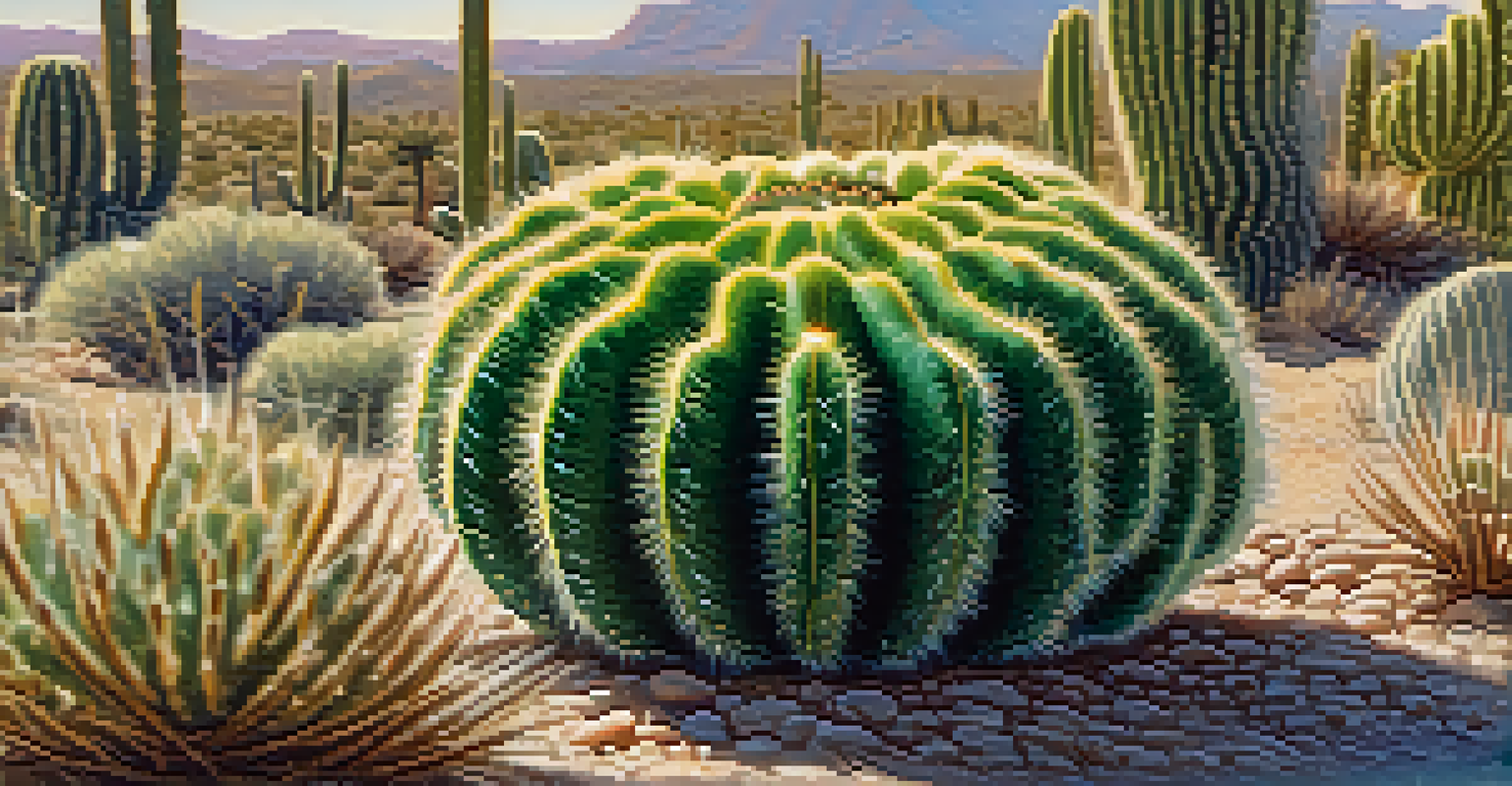Peyote and the Transformation of Spiritual Beliefs in Mexico

Understanding Peyote: A Sacred Cactus of Mexico
Peyote is a small, spineless cactus native to Mexico, known scientifically as Lophophora williamsii. This unique plant has been used for centuries in various indigenous cultures, primarily for its psychoactive properties. Its significance goes beyond mere hallucinogenic effects; peyote is often considered a sacred gift from the Earth, facilitating deep spiritual connections.
Peyote is not just a plant, but a sacred gift from the Earth that enables us to connect deeply with the spirit world.
For many indigenous groups, including the Huichol and the Navajo, peyote is central to their religious practices and cultural identity. Rituals involving peyote are seen as a way to communicate with the spirit world, heal the sick, and seek guidance. The act of consuming peyote during these ceremonies is a profound experience that fosters community and personal reflection.
The use of peyote in spiritual contexts highlights the intricate relationship between nature and belief systems in Mexico. This cactus serves not just as a tool for introspection, but as a symbol of resilience and continuity in the face of colonial pressures. Understanding its role requires an appreciation of the cultural narratives surrounding it.
Historical Context: Peyote in Indigenous Traditions
Peyote's history in Mexico dates back thousands of years, with evidence of its use found in archaeological sites. Indigenous tribes have incorporated the cactus into their spiritual practices long before European contact, showcasing a rich tradition that values nature's gifts. This history is not just about the plant itself; it reflects a broader worldview that sees humans as interconnected with all living things.

During colonial times, the Spanish sought to suppress indigenous beliefs, labeling peyote use as heretical. However, many indigenous communities resisted these efforts, leading to a complex interplay between tradition and colonial influence. The resilience of these practices demonstrates the strength of cultural identity among indigenous peoples.
Peyote's Sacred Role in Culture
Peyote is considered a sacred gift in indigenous cultures, facilitating spiritual connections and community healing.
Today, peyote is recognized as an essential aspect of cultural heritage, with efforts to protect its use amid growing interest and demand. Understanding this historical context is crucial for appreciating the depth of meaning attributed to peyote in spiritual beliefs and practices.
Modern Spiritual Movements and Peyote
In recent decades, there has been a resurgence of interest in peyote, not just among indigenous groups but also in broader spiritual movements. Many people seek out peyote ceremonies as a means of personal transformation and healing, often drawn by the allure of its psychoactive properties. This trend reflects a growing desire for alternative spiritual experiences in a fast-paced modern world.
To understand peyote is to appreciate the intricate relationship between culture, spirituality, and nature.
However, the influx of outsiders participating in peyote ceremonies raises important questions about cultural appropriation. It is vital to approach these practices with respect and understanding, recognizing their origins and the significance they hold for indigenous communities. Engaging in these ceremonies should prioritize the voices and traditions of those who have long practiced them.
The modern spiritual landscape, infused with peyote practices, illustrates a dynamic evolution of belief systems. As more individuals seek connection and meaning, the role of peyote continues to transform, serving as a bridge between ancient traditions and contemporary spiritual exploration.
The Role of Peyote in Healing Practices
Peyote is often associated with healing, both physically and spiritually, in many indigenous cultures. The ceremonies involving peyote can lead to profound insights and emotional release, helping individuals confront traumas and find clarity. This healing aspect is not merely anecdotal; many participants report transformative experiences that contribute to their well-being.
In traditional healing practices, peyote is typically consumed in a ceremonial context, guided by experienced shamans or spiritual leaders. These figures play a crucial role in navigating the journey, ensuring the safety and support of participants. The communal aspect of these rituals fosters a sense of belonging and shared purpose, enhancing the healing process.
Healing Benefits of Peyote
Ceremonial use of peyote often leads to profound insights and emotional healing, with potential benefits for mental health.
With increasing recognition of alternative medicine, the therapeutic potential of peyote is gaining attention in broader health discussions. While research is still in its early stages, preliminary studies suggest that peyote may have benefits for mental health, particularly in treating conditions like PTSD and depression.
Legal and Ethical Considerations Surrounding Peyote
The legal status of peyote is complex, particularly in the United States and Mexico. In the U.S., its use is protected for recognized Native American religious practices, but outside these contexts, legality is murky. This legal framework underscores the importance of respecting indigenous rights and ensuring their practices are safeguarded against exploitation.
In Mexico, peyote is legally protected for indigenous use, yet it faces threats from overharvesting and habitat loss. The increasing demand for peyote, fueled by non-indigenous interest, poses significant risks to its sustainability. Ethical considerations surrounding its use must prioritize conservation and the rights of indigenous communities.
Navigating these legal and ethical landscapes requires a nuanced understanding of the cultural significance of peyote. As discussions around drug policy and indigenous rights evolve, it is essential to advocate for practices that honor the traditions and wisdom of those who have cultivated these beliefs for centuries.
Connecting Spirituality and Nature Through Peyote
Peyote serves as a powerful reminder of the connection between spirituality and the natural world. For many indigenous peoples, the act of consuming peyote is not just about the experience itself but about honoring the earth and its gifts. This perspective fosters a deep respect for nature, emphasizing the need for environmental stewardship in spiritual practices.
The rituals surrounding peyote often involve elements of nature, such as songs, prayers, and offerings, creating a holistic experience that intertwines spirituality with the environment. This connection can inspire participants to adopt more sustainable practices in their daily lives, reflecting the values learned during ceremonies.
Legal and Ethical Challenges Ahead
The complex legal status of peyote highlights the need to respect indigenous rights while addressing sustainability concerns.
By recognizing the intrinsic link between peyote and nature, we can cultivate a deeper appreciation for the world around us. This awareness encourages a shift in mindset, promoting ecological consciousness that aligns with many spiritual beliefs centered on harmony with the earth.
The Future of Peyote and Spiritual Practices in Mexico
As interest in peyote continues to grow, the future of its use in spiritual practices remains a topic of significant discussion. Balancing cultural preservation with the burgeoning demand presents challenges for indigenous communities. Ensuring that these practices are maintained authentically, without succumbing to commercialization, is critical for their survival.
Community-led efforts to educate outsiders about the cultural significance of peyote are essential in fostering respect and understanding. Initiatives that promote sustainable harvesting and conservation are also crucial in protecting peyote's natural habitat. The resilience of indigenous cultures in adapting to modern challenges will determine the future trajectory of peyote practices.

Ultimately, the evolving narrative around peyote reflects broader themes of cultural identity, spirituality, and environmental stewardship. By honoring the traditions and wisdom of indigenous peoples, we can ensure that the sacred role of peyote continues to thrive in Mexico's spiritual landscape.